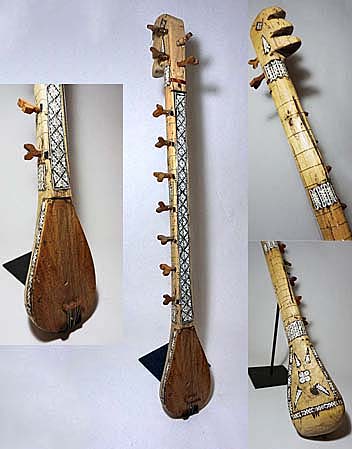
Owner: HWMC
Catalog#: 2AS-CHLT-04-16
Lutes
Afghanistan ‘Tanbur’
Northeast, in Mazar-i-Sharif and Kabul, Afghanistan
Afghans
Wood, bone, steel strings, metal, nylon strings
Mid 20th century
Length: 34.5 in, Width: 5 in, Depth: 5.75 in
Chordophones – Lutes
This tanbur (or tambur) is mainly played in the Northeast, in Mazar-i-Sharif and Kabul, Afghanistan. It looks similar to the herati dutar used in the town of Herat (West Afghanistan), however the body of this northeastern afghan tanbur is rounder, and the neck is hollow.
The body is carved from one piece of mulberry wood and has a wooden sound board. The separate hallowed out neck with a thin piece of wood for the finger board that is flush with the resonator sound board, the peg head on top, and the rim and body of the wooden resonator are all inlaid throughout with black and white bone decoration, stylized in geometric and arrowhead patterns. There are also, many small sound holes drilled into the face of the wooden body, and the bridge. This tanbur has three courses of metal strings, which run over a wooden bridge on the right side, at the end of the body, while the resonance strings run through holes on the left side of the bridge. There are 18 nylon frets situated underneath the copper and steel wire strings. At the left side of the neck are seven pegs for the extra resonance strings. These strings are tied inside the neck to the pegs, and each runs over its own a metal pin bridge. The Afghan tanbur is played with a wire finger plectrum.
Reference: ATLAS of Plucked Instruments – Central Asia
